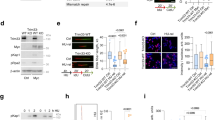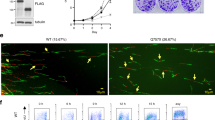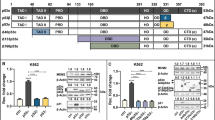Abstract
RECQ4 is a member of the RecQ helicase family, which has been implicated in the regulation of DNA replication, recombination and repair. p53 modulates the functions of RecQ helicases including BLM and WRN. In this study, we demonstrate that p53 can regulate the transcription of RECQ4. Using nontransformed, immortalized normal human fibroblasts, we show that p53-dependent downregulation of RECQ4 expression occurred in G1-arrested cells, both in the absence or presence of exogenous DNA damage. Wild-type p53 (but not the tumor-derived mutant forms) repressed RECQ4 promoter activity. The camptothecin or etoposide-dependent p53-mediated repression was attenuated by trichostatin A (TSA), an inhibitor of histone deacetylases (HDACs). Repression of the RECQ4 promoter was accompanied with an increased accumulation of HDAC1, and the loss of SP1 and p53 binding to the promoter. The simultaneous formation of a camptothecin-dependent p53-SP1 complex indicated its occurrence outside of the RECQ4 promoter. These data suggest that p53-mediated repression of RECQ4 transcription during DNA damage results from the modulation of the promoter occupancy of transcription activators and repressors.
This is a preview of subscription content, access via your institution
Access options
Subscribe to this journal
Receive 50 print issues and online access
$259.00 per year
only $5.18 per issue
Buy this article
- Purchase on Springer Link
- Instant access to full article PDF
Prices may be subject to local taxes which are calculated during checkout





Similar content being viewed by others
References
Appella E and Anderson CW . (2001). Eur. J. Biochem., 268, 2764–2772.
Bargonetti J, Chicas A, White D and Prives C . (1997). Cell. Mol. Biol. (Noisy-le-grand), 43, 935–949.
Brooks CL and Gu W . (2003). Curr. Opin. Cell. Biol., 15, 164–171.
Brummelkamp TR, Bernards R and Agami R . (2002). Science, 296, 550–553.
Davalos AR and Campisi J . (2003). J. Cell Biol., 162, 1197–1209.
Drouin CA, Mongrain E, Sasseville D, Bouchard HL and Drouin M . (1993). J. Am. Acad. Dermatol., 28, 301–305.
Eden S, Hashimshony T, Keshet I, Cedar H and Thorne AW . (1998). Nature, 394, 842.
el-Deiry WS, Tokino T, Velculescu VE, Levy DB, Parsons R, Trent JM, Lin D, Mercer WE, Kinzler KW and Vogelstein B . (1993). Cell, 75, 817–825.
el-Khoury JM, Haddad SN and Atallah NG . (1997). Br. J. Radiol., 70, 215–218.
Ferreira R, Naguibneva I, Mathieu M, Ait-Si-Ali S, Robin P, Pritchard LL and Harel-Bellan A . (2001). EMBO Rep., 2, 794–799.
Fuchs B and Pritchard DJ . (2002). Clin. Orthop., 40–52.
Furuichi Y . (2001). Ann. N. Y. Acad. Sci., 928, 121–131.
Ghoshal K, Datta J, Majumder S, Bai S, Dong X, Parthun M and Jacob ST . (2002). Mol. Cell. Biol., 22, 8302–8319.
Gottifredi V, Shieh S, Taya Y and Prives C . (2001). Proc. Natl. Acad. Sci. USA, 98, 1036–1041.
Haupt Y, Robles AI, Prives C and Rotter V . (2002). Oncogene, 21, 8223–8231.
Hickson ID . (2003). Nat. Rev. Cancer, 3, 169–178.
Hinds PW, Finlay CA, Quartin RS, Baker SJ, Fearson ER, Vogelstein B and Levine AJ . (1990). Cell Growth Differ., 1, 571–580.
Ho J and Benchimol S . (2003). Cell Death Differ., 10, 404–408.
Hofseth LJ, Hussain SP and Harris CC . (2004). Trends Pharmacol. Sci., 25, 177–181.
Hoki Y, Araki R, Fujimori A, Ohhata T, Koseki H, Fukumura R, Nakamura M, Takahashi H, Noda Y, Kito S and Abe M . (2003). Hum. Mol. Genet., 12, 2293–2299.
Hollstein M, Sidransky D, Vogelstein B and Harris CC . (1991). Science, 253, 49–53.
Horikoshi N, Usheva A, Chen J, Levine AJ, Weinmann R and Shenk T . (1995). Mol. Cell. Biol., 15, 227–234.
Jones PL, Veenstra GJ, Wade PA, Vermaak D, Kass SU, Landsberger N, Strouboulis J and Wolffe AP . (1998). Nat. Genet., 19, 187–191.
Kawabe T, Tsuyama N, Kitao S, Nishikawa K, Shimamoto A, Shiratori M, Matsumoto T, Anno K, Sato T, Mitsui Y, Seki M, Enomoto T, Goto M, Ellis NA, Ide T, Furuichi Y and Sugimoto M . (2000). Oncogene, 19, 4764–4772.
Kitao S, Lindor NM, Shiratori M, Furuichi Y and Shimamoto A . (1999). Genomics, 61, 268–276.
Kitao S, Ohsugi I, Ichikawa K, Goto M, Furuichi Y and Shimamoto A . (1998). Genomics, 54, 443–452.
Ko LJ and Prives C . (1996). Genes Dev., 10, 1054–1072.
Koshiji M, Kageyama Y, Pete EA, Horikawa I, Barrett JC and Huang LE . (2004). EMBO J., 23, 1949–1956.
Koumenis C, Alarcon R, Hammond E, Sutphin P, Hoffman W, Murphy M, Derr J, Taya Y, Lowe SW, Kastan M and Giaccia A . (2001). Mol. Cell. Biol., 21, 1297–1310.
Krause K, Wasner M, Reinhard W, Haugwitz U, Dohna CL, Mossner J and Engeland K . (2000). Nucleic Acids Res., 28, 4410–4418.
Langley E, Pearson M, Faretta M, Bauer UM, Frye RA, Minucci S, Pelicci PG and Kouzarides T . (2002). EMBO J., 21, 2383–2396.
Lee D, Kim JW, Seo T, Hwang SG, Choi EJ and Choe J . (2002). J. Biol. Chem., 277, 22330–22337.
Levine AJ, Momand J and Finlay CA . (1991). Nature, 351, 453–456.
Li B and Lee MY . (2001). J. Biol. Chem., 276, 29729–29739.
Lin J, Chen J, Elenbaas B and Levine AJ . (1994). Genes. Dev., 8, 1235–1246.
Luo J, Nikolaev AY, Imai S, Chen D, Su F, Shiloh A, Guarente L and Gu W . (2001). Cell, 107, 137–148.
Luo J, Su F, Chen D, Shiloh A and Gu W . (2000). Nature, 408, 377–381.
Michalovitz D, Halevy O and Oren M . (1991). J. Cell Biochem., 45, 22–29.
Mirza A, McGuirk M, Hockenberry TN, Wu Q, Ashar H, Black S, Wen SF, Wang L, Kirschmeier P, Bishop WR, Nielsen LL, Pickett CB and Liu S . (2002). Oncogene, 21, 2613–2622.
Mishra SK, Mandal M, Mazumdar A and Kumar R . (2001). FEBS Lett., 507, 88–94.
Munger K and Howley PM . (2002). Virus Res., 89, 213–228.
Murphy M, Ahn J, Walker KK, Hoffman WH, Evans RM, Levine AJ and George DL . (1999). Genes Dev., 13, 2490–2501.
Oren M, Damalas A, Gottlieb T, Michael D, Taplick J, Leal JF, Maya R, Moas M, Seger R, Taya Y and Ben-Ze’Ev A . (2002). Ann. N. Y. Acad. Sci., 973, 374–383.
Pal S, Datta K and Mukhopadhyay D . (2001). Cancer Res., 61, 6952–6957.
Perrem K, Rayner J, Voss T, Sturzbecher H, Jackson P and Braithwaite A . (1995). Oncogene, 11, 1299–1307.
Puvion-Dutilleul F, Besse S, Diaz JJ, Kindbeiter K, Vigneron M, Warren SL, Kedinger C, Madjar JJ and Puvion E . (1997). Gene Expr., 6, 315–332.
Santhanam U, Ray A and Sehgal PB . (1991). Proc. Natl. Acad. Sci. USA, 88, 7605–7609.
Sengupta S and Harris CC . (2005). Nat. Rev. Mol. Cell. Biol., 6, 44–55.
Sengupta S, Linke SP, Pedeux R, Yang Q, Farnsworth J, Garfield SH, Valerie K, Shay JW, Ellis NA, Wasylyk B and Harris CC . (2003). EMBO J., 22, 1210–1222.
Sengupta S, Robles AI, Linke SP, Sinogeeva NI, Zhang R, Pedeux R, Ward IM, Celeste A, Nussenzweig A, Chen J, Halazonetis TD and Harris CC . (2004). J. Cell Biol., 166, 801–813.
Sengupta S and Wasylyk B . (2001). Genes Dev., 15, 2367–2380.
Seto E, Usheva A, Zambetti GP, Momand J, Horikoshi N, Weinmann R, Levine AJ and Shenk T . (1992). Proc. Natl. Acad. Sci. USA, 89, 12028–12032.
Shimamoto A, Sugimoto M and Furuichi Y . (2004). Int. J. Clin. Oncol., 9, 288–298.
Subbaramaiah K, Altorki N, Chung WJ, Mestre JR, Sampat A and Dannenberg AJ . (1999). J. Biol. Chem., 274, 10911–10915.
Thut CJ, Chen JL, Klemm R and Tjian R . (1995). Science, 267, 100–104.
Vaziri H, Dessain SK, Ng Eaton E, Imai SI, Frye RA, Pandita TK, Guarente L and Weinberg RA . (2001). Cell, 107, 149–159.
Vennos EM and James WD . (1995). Dermatol. Clin., 13, 143–150.
Vogelstein B, Lane D and Levine AJ . (2000). Nature, 408, 307–310.
Wang LL, Gannavarapu A, Kozinetz CA, Levy ML, Lewis RA, Chintagumpala MM, Ruiz-Maldanado R, Contreras-Ruiz J, Cunniff C, Erickson RP, Lev D, Rogers M, Zackai EH and Plon SE . (2003). J. Natl. Cancer Inst., 95, 669–674.
Wang XW, Tseng A, Ellis NA, Spillare EA, Linke SP, Robles AI, Seker H, Yang Q, Hu P, Beresten S, Bemmels NA, Garfield S and Harris CC . (2001). J. Biol. Chem., 276, 32948–32955.
Webster NJ, Resnik JL, Reichart DB, Strauss B, Haas M and Seely BL . (1996). Cancer Res., 56, 2781–2788.
Xu D, Wang Q, Gruber A, Bjorkholm M, Chen Z, Zaid A, Selivanova G, Peterson C, Wiman KG and Pisa P . (2000). Oncogene, 19, 5123–5133.
Yamabe Y, Shimamoto A, Goto M, Yokota J, Sugawara M and Furuichi Y . (1998). Mol. Cell. Biol., 18, 6191–6200.
Yin J, Kwon YT, Varshavsky A and Wang W . (2004). Hum. Mol. Genet., 13, 2421–2430.
Zambetti GP and Levine AJ . (1993). FASEB J., 7, 855–865.
Zhao R, Gish K, Murphy M, Yin Y, Notterman D, Hoffman WH, Tom E, Mack DH and Levine AJ . (2000). Genes Dev., 14, 981–993.
Acknowledgements
We thank Bert Vogelstein, Arnold J Levine and John Bradsher for the gifts of the recombinants and antibody. We also thank Dorothea Dudek for editorial assistance and Karen MacPherson for bibliographic assistance.
Author information
Authors and Affiliations
Corresponding author
Additional information
Supplementary Information accompanies the paper on Oncogene website (http://www.nature.com/onc)
Supplementary information
Rights and permissions
About this article
Cite this article
Sengupta, S., Shimamoto, A., Koshiji, M. et al. Tumor suppressor p53 represses transcription of RECQ4 helicase. Oncogene 24, 1738–1748 (2005). https://doi.org/10.1038/sj.onc.1208380
Received:
Revised:
Accepted:
Published:
Issue Date:
DOI: https://doi.org/10.1038/sj.onc.1208380
Keywords
This article is cited by
-
Census and evaluation of p53 target genes
Oncogene (2017)
-
p53 downregulates the Fanconi anaemia DNA repair pathway
Nature Communications (2016)
-
p53-dependent gene repression through p21 is mediated by recruitment of E2F4 repression complexes
Oncogene (2014)
-
p53 Binds to Estrogen Receptor 1 Promoter in Human Breast Cancer Cells
Pathology & Oncology Research (2012)
-
Rothmund-Thomson syndrome
Orphanet Journal of Rare Diseases (2010)



